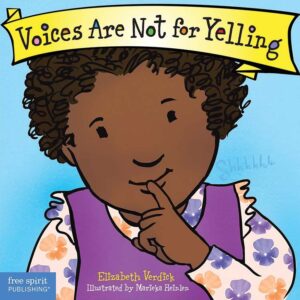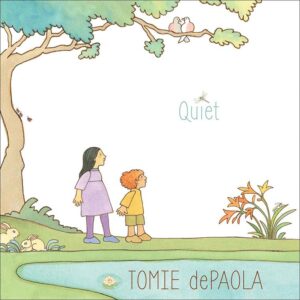Social interaction skills, Awareness of emotions
Toddlers participate in a book sharing about loud and quiet voices.



Be Prepared: Limit participation to no more than three toddlers so all children can see the pictures in the small board book.
 [Invite up to three toddlers to join you in reading a book about our voices.
[Invite up to three toddlers to join you in reading a book about our voices.
Display book cover. Point to book title as you read it.]
Here is the cover of the book we will look at together. Our book is called Voices Are Not for Yelling.
Please look at the girl on the cover of our book.
Our book tells us about being inside and being outside. Inside means we are inside a building. We might be in a room like our room or the hallway of our building. We might be in our home or an office or store. These are inside places.
Let’s all point to where we go when we go outside.
[Lead toddlers in pointing to an outside area.]
[Read the book’s text and use your own words to describe pictures and elaborate on text you wish to emphasize, such as the following:
Describe (or encourage toddlers to describe) how we take slow and deep breaths to calm down when we are excited or mad. Lead toddlers in breathing slowly and deeply.]
All of us have an inside voice and an outside voice. An inside voice is quiet. An outside voice is loud. Sometimes our voice is really loud when we get excited or mad. People may have a hard time hearing our words when we use a really loud voice or we yell. It is easier for people to hear our words when we use a quieter voice.
Feeling excited and mad are explored in prior ELM activities. The current activity can help toddlers connect quieter and louder voices to feeling excited or mad. The activity also emphasizes benefits of getting calm: (1) we can use a quieter voice, and (2) other people can hear our words better when we use a quieter voice. Our words are hard to hear when we use a really loud voice or we yell.
The activity description suggests that toddlers briefly practice breathing deeply and slowly as a way to calm down. This technique is introduced early in ELM Curriculum activities for older toddlers (Block 2, Self-Regulation) and regularly included in other activities (example: Block 21, Social-Emotional). Watching toddlers’ efforts during a brief practice in the current activity can help you identify toddlers who may benefit from further support for calming their minds and bodies.
Extra support
Enrichment
Social interaction skills, Awareness of emotions
Toddlers participate in a book sharing about being quiet.



 Invite 3–4 toddlers to join you to share a book about being quiet. Show and describe the book cover. Emphasize that the two children are taking time to look at something, maybe the dragonfly that is just above the book title. Explain that our story tells about the two children, dog, and older man shown opposite the title page inside the book (also shown on first text page).
Invite 3–4 toddlers to join you to share a book about being quiet. Show and describe the book cover. Emphasize that the two children are taking time to look at something, maybe the dragonfly that is just above the book title. Explain that our story tells about the two children, dog, and older man shown opposite the title page inside the book (also shown on first text page).
Read the book’s text and pause on each page so toddlers have time to look carefully at the rich illustrations. Respond to toddler comments or pointing. Emphasize the following:
Conclude the book discussion by engaging toddlers in a brief discussion of why it is special to be quiet and still. Ask why we can think better when we are quiet and see better when we are still. Show the pertinent pages of the book (girl thinking, boy seeing) to support toddlers’ exploration of these questions.
The book featured in this activity extends ideas offered in prior activities, especially good things that can happen when we are calm. Option 1 promotes the idea that people can better hear our words when we use a quieter voice. The Quiet book used in the current activity emphasizes more benefits: we can think better and we can see better when we are calm. The engaging illustrations and quiet quality of the book will appeal to many toddlers. Look for ways to help toddlers connect the book’s description of trees “waving their leaves” and being still to the experience of pretending to be a tree (Self-Regulation activities in current block and Block 22).
Extra support
Enrichment
Materials Needed: Voices Are Not for Yelling (Board Book) by Elizabeth Verdick, Quiet by Tomie dePaola
Offer a calm activity for toddlers by making the two books available in a quiet area of the room and encouraging toddlers to look at smaller things shown in each book’s pictures. As examples, point to small letter blocks and fish on the first page of the Voices Are Not for Yelling book, and the variety of insects and the animal family shown on the first page of the Quiet book. Explain that being calm can help us look carefully. Encourage toddlers to talk about features of book illustrations they did not notice when the book was shared in a small gathering of friends. It is not necessary for toddlers to know the names of things they see in illustrations. What’s important is noticing the smaller aspects of pictures.
Materials Needed: see activity description
Preschool-age children may enjoy participating in Options 1 and 2. The illustrations of the Quiet book in Option 2 are likely to appeal to younger toddlers (12–24 months) and mobile infants. Mobile infants may enjoy manipulating and looking at the board book used in Option 1.